Chemical Characteristics of Atmospheric PM10 and PM2.5 at a Rural Site of Lijiang City, China
Abstract
1. Introduction
2. Materials and Methodology
2.1. Sampling Site
2.2. Aerosol Sampling
2.3. Analytical Method
3. Results and Discussion
3.1. PM10 and PM2.5 Concentrations
3.2. OC/EC
3.3. PAHs and NPAHs
3.4. Water-Soluble Inorganic Ions
3.5. Elemental Composition
4. Conclusions
Author Contributions
Funding
Acknowledgments
Conflicts of Interest
References
- Crutzen, P.J.; Andreae, M.O. Biomass burning in the tropics: Impact on atmospheric chemistry and biogeochemical cycles. J. Sci. 1990, 250, 1669–1678. [Google Scholar] [CrossRef] [PubMed]
- Andreae, M.O. Biomass burning: Its history, use, and distribution and its impact on environmental quality and global climate. In Global Biomass Burning: Atmospheric, Climatic, and Biospheric Implications; MIT Press, Mass: Cambridge, UK, 1991; pp. 3–21. [Google Scholar]
- Penner, J.E.; Dickinson, R.E.; O’Neill, R.E. Effects of aerosol from biomass burning on the global radiation budget. J. Sci. 1992, 256, 1432–1434. [Google Scholar] [CrossRef] [PubMed]
- Taylor, D. Biomass burning, humans and climate change in Southeast Asia. J. Biodivers. Conserv. 2010, 19, 1025–1042. [Google Scholar] [CrossRef]
- Ramanathan, V.; Agrawal, M.; Akimoto, H. Atmospheric Brown Clouds: Regional Assessment Report with Focus on Asia; United Nations Environment Programme: Bangkok, Thailand, 2008. [Google Scholar]
- Reid, J.S.; Xian, P.; Hyer, E.J.; Flatau, M.K.; Ramirez, E.M.; Turk, F.J.; Sampson, C.R.; Zhang, C.; Fukada, E.M.; Maloney, E.D. Multi-scale meteorological conceptual analysis of observed active fire hotspot activity and smoke optical depth in the Maritime Continent. Atmos. Chem. Phys. 2012, 12, 2117–2147. [Google Scholar] [CrossRef]
- Sheng, H.W.; Si, C.T.; Neng, H.L. Origin, transport, and vertical distribution of atmospheric pollutants over the northern South China Sea during the 7-SEAS/Dongsha Experiment. Atmos. Environ. 2013, 78, 124–133. [Google Scholar]
- Liu, H.; Chang, W.L.; Oltmans, S.J. On springtime high ozone events in the lower troposphere from Southeast Asian biomass burning. Atmos. Environ. 1999, 33, 2403–2410. [Google Scholar] [CrossRef]
- Wu, G.; Ram, K.; Fu, P. Water-soluble Brown Carbon in Atmospheric Aerosols from Godavari (Nepal), A Regional Representative of South Asia. J. Environ. Sci. Technol. 2019, 53, 3471–3479. [Google Scholar] [CrossRef]
- Qin, S.G.; Ding, A.J.; Wang, T. Transport pattern of biomass burnings air masses in Eurasia and the impacts on China. China Environ. Sci. 2006, 26, 641–645. [Google Scholar]
- Zhou, R.; Zhu, J. Study on the influence of transport of biomass burning materials from Southeast Asia on aerosol radiation effects in Southwest China. J. China Environ. Sci. 2020, 40, 1429–1436. [Google Scholar]
- Zhang, Y.Q.; Yang, Y.C.; Li, J. Modeling the impacts of biomass burning in southeast Asia on PM2.5 over China in spring. J. Res. Environ. Sci. 2016, 29, 952–962. [Google Scholar]
- Ma, Y.; Weber, R.J.; Lee, Y.N.; Orsini, D.A.; Maxwell-Meier, K.; Thornton, D.C.; Bandy, A.R.; Clarke, A.D.; Blake, D.R.; Sachse, G.W.; et al. Characteristics and influence of biosmoke on the fine-particle ionic composition measured in Asian outflow during the Transport and Chemical Evolution over the Pacific (TRACE–P) experiment. J. Geophys. Res. Atmos. 2003, 108, 8816p. [Google Scholar] [CrossRef]
- Maenhaut, W.; Salma, I.; Cafmeyer, J.; Annegarn, H.J.; Andreae, M.O. Regional atmospheric aerosol composition and sources in the eastern Transvaal, South Africa, and impact of biomass burning. J. Geophys. Res. Atmos. 1996, 101, 23631–23650. [Google Scholar] [CrossRef]
- Wang, X.; Zhang, H.; Lin, C.J. Transboundary transport and deposition of Hg emission from springtime biomass burning in the Indo-China Peninsula. J. Geophys. Res. Atmos. 2015, 120, 9758–9771. [Google Scholar] [CrossRef]
- Lyu, Y.B.; Tan, L.; Teng, E.J.; Wang, C.; Lyu, T.F.; Liang, X. Concentration levels and composition characteristics of VOCs at the background locations in China. Environ. Chem. 2013, 32, 726–733. [Google Scholar]
- Liu, Z.R.; Wang, Y.S.; Liu, Q.; Liu, L.N.; Zhang, D.Q. Pollution Characteristics and Source of the Atmospheric Fine Particles and Secondary Inorganic Compounds at Mount Dinghu in Autumn Season. Environ. Sci. 2011, 32, 3160–3166. [Google Scholar]
- Kalisa, E.; Nagato, E.; Bizuru, E. Pollution characteristics and risk assessment of ambient PM2.5-bound PAHs and NPAHs in typical Japanese and New Zealand cities and rural sites. J. Atmos. Pollut. Res. 2019, 10, 1396–1403. [Google Scholar] [CrossRef]
- Chow, J.C.; Watson, J.G.; Pritchett, L.C.; Pierson, W.R.; Frazier, C.A.; Purcell, R.G. The DRI thermal/optical reflectance carbon analysis system: Description, evaluation and applications in US air quality studies. Atmos. Environ. 1993, 27, 1185–1201. [Google Scholar] [CrossRef]
- Yang, X.Y.; Igarashi, K.; Tang, N. Indirect- and direct-acting mutagenicity of diesel, coal and wood burning-derived particulates and contribution of polycyclic aromatic hydrocarbons and nitropolycyclic aromatic hydrocarbons. J. Mutat. Res./Genet. Toxicol. Environ. Mutagenes. 2010, 695, 29–34. [Google Scholar] [CrossRef]
- Wang, W. Inorganic and Organic Speciation of Atmospheric Aerosols by Ion Chromatography and Aerosol Chemical Mass Closure. Ph.D. Thesis, Ghent University, Ghent, Belgium, 2010. [Google Scholar]
- Xue, Y.Y.; Liu, G.H.; Tian, H.J.; Wu, T. Determination of Heavy Metal Elements in PM2.5 in Taiyuan by ICP-MS. Guangzhou Chem. 2016, 41, 45–48. [Google Scholar]
- Ministry of Ecology and Environment of the People’s Republic of China. GB 3095-2012 Ambient Air Quality Standard; Ministry of Ecology and Environment of the People’s Republic of China: Beijing, China, 2016. [Google Scholar]
- Zhang, L.L.; Dao, X.; Wang, C. Characterization of air particulate matters and elements in four national background locations, China. J. Environ. Chem. 2015, 34, 70–76. [Google Scholar]
- Dao, X.; Wang, C.; Zhang, L.L. Characteristics of mass and water-soluble ionic compounds in atmospheric particles (PM2.5\PM10) of four National Atmospheric Backgrounds. J. Environ. Chem. 2015, 34, 1095–1102. [Google Scholar]
- Lim, S.; Lee, M.; Lee, G.; Kim, S.; Yoon, S.; Kang, K. Ionic and carbonaceous compositions of PM10, PM2.5 and PM1.0 at Gosan ABC Superstation and their ratios as source signature. Atmos. Chem. Phys. 2012, 12, 2007–2024. [Google Scholar] [CrossRef]
- Lee, S.B.; Bae, G.N.; Moon, K.C. Characteristics of TSP and PM2.5 measured at Tokchok Island in the Yellow Sea. J. Atmos. Environ. 2002, 36, 5427–5435. [Google Scholar] [CrossRef]
- Maenhaut, W.; Raes, N.; Chi, X.G. Chemical composition and mass closure for PM2.5 and PM10 aerosols at K-puszta, Hungary, in summer 2006. J. X-ray Spectrom. 2008, 37, 193–197. [Google Scholar] [CrossRef]
- Chi, X.G. Development of Improved Sampling and Analysis Method for Measuring Organic, Elemental, and Water Soluble Organic Carbon in Atmospheric Aerosols and Application to Aerosol Studies in Europe and Tropical/Equatorial and Oceanic Regions. Ph.D. Thesis, Ghent University, Ghent, Belgium, 2009. [Google Scholar]
- Barmpadimos, I.; Keller, J.; Oderbolz, D. One decade of parallel fine (PM2.5) and coarse (PM10-PM2.5) particulate matter measurements in Europe: Trends and variability. J. Atmos. Chem. Phys. Atmos. Chem. Phys. 2012, 12, 3189–3203. [Google Scholar] [CrossRef]
- Luo, Y.K.; Chan, C.Y.; Zhang, Y.N.; Eng, L.G.; Zhang, Z.S.; Sang, X.F.; Wang, X.M. Characteristics and sources of carbonaceous aerosols in spring at four background sites in South China. China Environ. Sci. 2010, 30, 1543–1549. [Google Scholar]
- Li, A.N.; Wen, T.X.; Hua, W.; Yang, Y.; Meng, Z.; Hu, B.; Xin, J.Y. Characterization and Size Distribution of Carbonaceous Aerosols at Mountain Dinghu. Environ. Sci. 2020, 41, 3908–3917. [Google Scholar]
- Zhang, D.; Chu, B.M.; Zhao, L.; Xia, P.C.; Yao, Y.W.; Wang, X.Q.; Xie, G.; Zhao, K. Characteristics and Source of Carbonaceous Species in PM of Lhasa City. Environ. Impact Assess. 2018, 40, 65–70. [Google Scholar]
- Appel, B.R.; Colodny, P.; Wesolowski, J.J. Analysis of carbonaceous material in Southern California atmospheric aerosols. J. Environ. Sci. Technol. 1976, 10, 359–363. [Google Scholar] [CrossRef]
- Chow, J.C.; Waston, J.G.; Lu, Z. Descriptive analysis of PM2.5 and PM10 at regionally representative locations during SJVAQS/AUSPEX. J. Atmos. Environ. 1996, 30, 2079–2112. [Google Scholar] [CrossRef]
- Wang, Y.N.; Jia, C.H.; Tao, J. Chemical characterization and source apportionment of PM2.5 in a semi-arid and petrochemical-industrialized city, Northwest China. J. Sci. Total Environ. 2016, 573, 1031–1040. [Google Scholar] [CrossRef] [PubMed]
- Yuan, X.Z.; Min, S.; Yuan, H.Z. Source profiles of particulate organic matters emitted from cereal straw burnings. J. Environ. Sci. 2007, 19, 167–175. [Google Scholar]
- Mei, D.Q.; Zhu, Z.N.; Sun, T.S.; Wang, X.L.; Mei, C.W.; Xiao, Z.Z. Size Distribution and Carbon Component Characteristics of Atmospheric Particulate Matter from Motor Vehicles. Environ. Sci. 2019, 40, 114–120. [Google Scholar]
- Li, Y.H.; Rao, Z.G.; Tan, J.H.; Duan, J.C.; Ma, Y.L.; He, K.B. Pollutional Characteristics and Sources Analysis of Polycyclic Aromatic Hydrocarbons in Atmospheric Fine Particulate Matter in Lanzhou City. Environ. Sci. 2016, 37, 2428–2435. [Google Scholar]
- Xia, B.X.; Ji, Z.Y.; Han, X.Y.; Zhang, C.N.; Ning, P.; Shi, J.W. Pollution characteristics and health risk assessment of PAHs in atmospheric particulates in Yuxi city. J. Environ. Chem. 2020, 39, 2093–2104. [Google Scholar]
- Wang, C.; Dao, X.; Zhang, L.L.; Lv, Y.B.; Teng, E.J. Characteristics and toxicity assessment of airborne particulate polycyclic aromatic hydrocarbons of four background sites in China. China Environ. Sci. 2015, 35, 3543–3549. [Google Scholar] [CrossRef]
- Souza, K.F.; Carvalho, L.R.F.; Allen, A.G.; Cardoso, A.A. Diurnal and nocturnal measurements of pah, nitro-pah, and oxy-pah compounds in atmospheric particulate matter of a sugar cane burning region. Atmos. Environ. 2014, 83, 193–201. [Google Scholar] [CrossRef]
- MA, S.X.; Zhang, X.; Chen, L.G.; Liu, M.; Tang, C.M.; Su, Y.H. Characteristics of PAHs concentration in the atmospheric PM2.5 in Wuzhi Mountain background in Hainan, South China. J. Environ. Sci. 2013, 33, 103–107. [Google Scholar]
- Niu, H.Y.; Zhao, X.; Dai, Z.X.; Wang, G.H.; Wang, L.S. Characterization, source apportionment of particulate matter and n-Alk in atmospheric aerosols in Nanjing City. J. Environ. Pollut. Control 2005, 27, 363–367. [Google Scholar]
- Rajput, P.; Sarin, M.M.; Rengarajan, R. Atmospheric polycyclic aromatic hydrocarbons (PAHs) from post-harvest biomass burning emissions in the Indo-Gangetic Plain: Isomer ratios and temporal trends. J. Atmos. Environ. 2011, 45, 6732–6740. [Google Scholar] [CrossRef]
- Wang, Z.Z.; Tan, J.H.; Bi, X.H.; He, Q.; Sheng, G.Y.; Fu, J.M. Emission characteristics of polycyclic aromatic hydrocarbons from three types of agricultural straw burning smoke. J. China Environ. Sci. 2015, 35, 1065–1071. [Google Scholar]
- Mark, B.Y.; Robie, W.M.; Roxanne, V.; Reginald, H.; Darcy, G.; Stephanie, S. PAHs in the Fraser River basin: A critical appraisal of PAH ratios as indicators of PAH source and composition. Org. Geochem. 2002, 33, 489–515. [Google Scholar]
- Liu, E.L.; Wang, F.H. Analysis on Source of the Polycyclic Aromatic Hydrocarbons in Jinan’s Atmosphere. J. Environ. Monit. China 2007, 23, 58–62. [Google Scholar]
- Tania, M.; Martina, G.; Luciano, L. One year intensive PM2.5 bound polycyclic aromatic hydrocarbons monitoring in the area of Tuscany, Italy. Concentrations, source understanding and implications. J. Environ. Pollut. 2012, 164, 252–258. [Google Scholar]
- Masiol, M.; Hofer, A.; Squizzato, S.; Piazza, R.; Rampazzo, G.; Pavoni, B. Carcinogenic and mutagenic risk associated to airborne particle-phase polycyclic aromatic hydrocarbons: A source apportionment. J. Atmos. Environ. 2012, 60, 375–382. [Google Scholar] [CrossRef]
- Kang, M.; Kim, K.; Choi, N. Recent Occurrence of PAHs and n-Alkanes in PM2.5 in Seoul, Korea and Characteristics of Their Sources and toxicity. J. Int. J. Environ. Res. Public Health 2020, 17, 1397. [Google Scholar] [CrossRef]
- Khalili, N.R.; Scheff, P.A.; Holsen, T.M. PAH source fingerprints for coke ovens, diesel and, gasoline engines, highway tunnels, and wood combustion emissions. J. Atmos. Environ. 1995, 29, 533–542. [Google Scholar] [CrossRef]
- Galarneau, E. Source specificity and atmospheric processing of airborne PAHs: Implications for source apportionment. J. Atmos. Environ. 2008, 42, 8139–8149. [Google Scholar] [CrossRef]
- Chuesaard, T.; Chetiyanukornkul, T.; Kameda, T.; Hayakawa, K.; Toriba, A. Influence of biomass burning on the levels of atmospheric polycyclic aromatic hydrocarbons and their nitro derivatives in Chiang Mai, Thailand. J. Aerosol Air Qual. Res. 2014, 14, 1247–1257. [Google Scholar] [CrossRef]
- Li, W.; Wang, C.; Shen, H.; Su, S.; Shen, G.; Huang, Y.; Zhang, Y.; Chen, Y.; Chen, H.; Lin, N.; et al. Concentrations and origins of nitro- polycyclic aromatic hydrocarbons and oxy-polycyclic aromatic hydrocarbons in ambient air in urban and rural areas in northern China. J. Environ. Pollut. 2015, 197, 156–164. [Google Scholar] [CrossRef]
- Kojima, Y.; Inazu, K.; Hisamatsu, Y.; Okochi, H.; Baba, T.; Nagoya, T. Influence of secondary formation on atmospheric occurrences of oxygenated polycyclic aromatic hydrocarbons in airborne particles. J. Atmos. Environ. 2010, 44, 2873–2880. [Google Scholar] [CrossRef]
- Osada, K.; Kido, M.; Nishita, C. Changes in ionic constituents of free tropospheric aerosol particles obtained at Mt. Norikura (2770m a.s.l.), central Japan, during the Shurin period in 2000. J. Atmos. Environ. 2002, 36, 5469–5477. [Google Scholar] [CrossRef]
- Zhang, N.N.; Cao, J.J.; Ho, K.F.; He, Y.Q. Chemical characterization of aerosol collected at Mt. Yulong in wintertime on the southeastern Tibetan Plateau. Atmos. Res. 2012, 107, 76–85. [Google Scholar] [CrossRef]
- Zhao, Y.N.; Wang, Y.S.; Wen, T.X.; Yang, Y.J.; Li, W. Observation and Analysis on Water-soluble Inorganic Chemical Compositions of Atmospheric Aerosol in Gongga Mountain. Environ. Sci. 2009, 30, 9–13. [Google Scholar]
- Zhao, Y.N.; Wang, Y.S.; Wen, T.X.; Dai, G.H. Observation and Analysis of Water-Soluble Inorganic Ions in PM2.5 From Mount Changbai. Environ. Chem. 2011, 30, 812–815. [Google Scholar]
- Lee, C.T.; Chuang, M.T.; Lin, N.H.; Wang, J.L.; Sheu, G.R.; Chang, S.C.; Wang, S.T.; Huang, H.; Chen, H.W.; Liu, Y.L.; et al. The enhancement of PM2.5 mass and water-soluble ions of biosmoke transported from Southeast Asia over the Mountain Lulin site in Taiwan. J. Atmos. Environ. 2011, 45, 5784–5794. [Google Scholar] [CrossRef]
- Chow, J.C. Measurement methods to determine compliance with ambient air quality standards for suspended particles. J. Air Waste Manag. Assoc. 1995, 45, 320–382. [Google Scholar] [CrossRef]
- Wang, W.; Maenhaut, W.; Yang, W.; Liu, X.D.; Bai, Z.P.; Zhang, T.; Claeys, M.; Cachier, H.; Dong, S.P.; Wang, Y.L. One–year aerosol characterization study for PM2.5 and PM10 in Beijing. J. Atmos. Pollut. Res. 2014, 5, 554–562. [Google Scholar] [CrossRef]
- Chuang, M.T.; Chou, C.K.; Sopajaree, K.; Lin, N.-H.; Wang, J.-L.; Sheu, G.-R.; Chang, Y.-J.; Lee, C.-T. Characterization of aerosol chemical properties from near-source biomass burning in the northern Indochina during 7-SEAS/Dongsha experiment. J. Atmos. Environ. 2013, 78, 72–81. [Google Scholar] [CrossRef]
- Yang, Y.J.; Wang, Y.S.; Wen, T.X.; Zhao, Y.N.; Li, J. Element Characteristics and Sources of PM2.5 at Mount Dinghu in 2006. J. Environ. Sci. 2009, 30, 988–992. [Google Scholar]
- Pan, Y.; Wang, Y.; Sun, Y.; Tian, S.; Cheng, M. Size-resolved aerosol trace elements at a rural mountainous site in Northern China: Importance of regional transport. J. Sci. Total Environ. 2013, 461, 761–771. [Google Scholar] [CrossRef] [PubMed]
- Shi, J.W.; Li, Z.Z.; Sun, Z.R.; Han, X.Y.; Shi, Z.; Xiang, F.; Ning, P. Specific features of heavy metal pollutant residue in PM2.5 and analysis of their damage level for human health in the urban air of Kunming. J. Saf. Environ. 2018, 18, 795–800. [Google Scholar]
- Zhou, X.M.; Zheng, N.J.; Li, Y.H.; Duan, J.C.; Tan, J.H.; Zhang, Y.X.; He, K.B.; Ma, Y.L. Chemical Characteristics and Sources of Heavy Metals in Fine Particles in Beijing in 2011–2012. J. Environ. Sci. 2017, 38, 4054–4060. [Google Scholar]
- Peng, X.; Shi, G.; Liu, G.; Xu, J.; Tian, Y.; Zhang, Y.; Feng, Y.; Russell, A.G. Source apportionment and heavy metal health risk (HMHR) quantification from sources in a southern city in China, using an ME2 -HMHR model. Environ. Pollut. 2017, 211, 335–342. [Google Scholar] [CrossRef]
- Wang, S.; Hu, G.; Yan, Y.; Wang, S.; Yu, R.; Cui, J. Source apportionment of metal elements in PM2.5 in a coastal city in southeast china: Combined pb-sr-nd isotopes with pmf method. Atmos. Environ. 2018, 198, 302–312. [Google Scholar] [CrossRef]
- Niu, Y.Y.; Wang, F.; Liu, S.M.; Zhang, W.J. Source analysis of heavy metal elements of PM2.5 in canteen in a university in winter. Atmos. Environ. 2021, 244, 117879. [Google Scholar] [CrossRef]
- Yang, T.J.; Yu, H.Y.; He, Y.J.; Miao, Y.G.; Gao, Y.G.; Li, N.; Wang, W. Characterization of Elemental Compositions and Their Sources of PM2.5 in Tangshan City. J. Res. Environ. Sci. 2020, 33, 52–61. [Google Scholar]
- Hao, Y.F.; Luo, B.; Simayi, M.; Zhang, W.; Jiang, Y.; He, J.M.; Xie, S.D. Spatiotemporal patterns of PM2.5 elemental composition over China and associated health risks. Environ. Pollut. 2020, 265, 114910. [Google Scholar] [CrossRef]
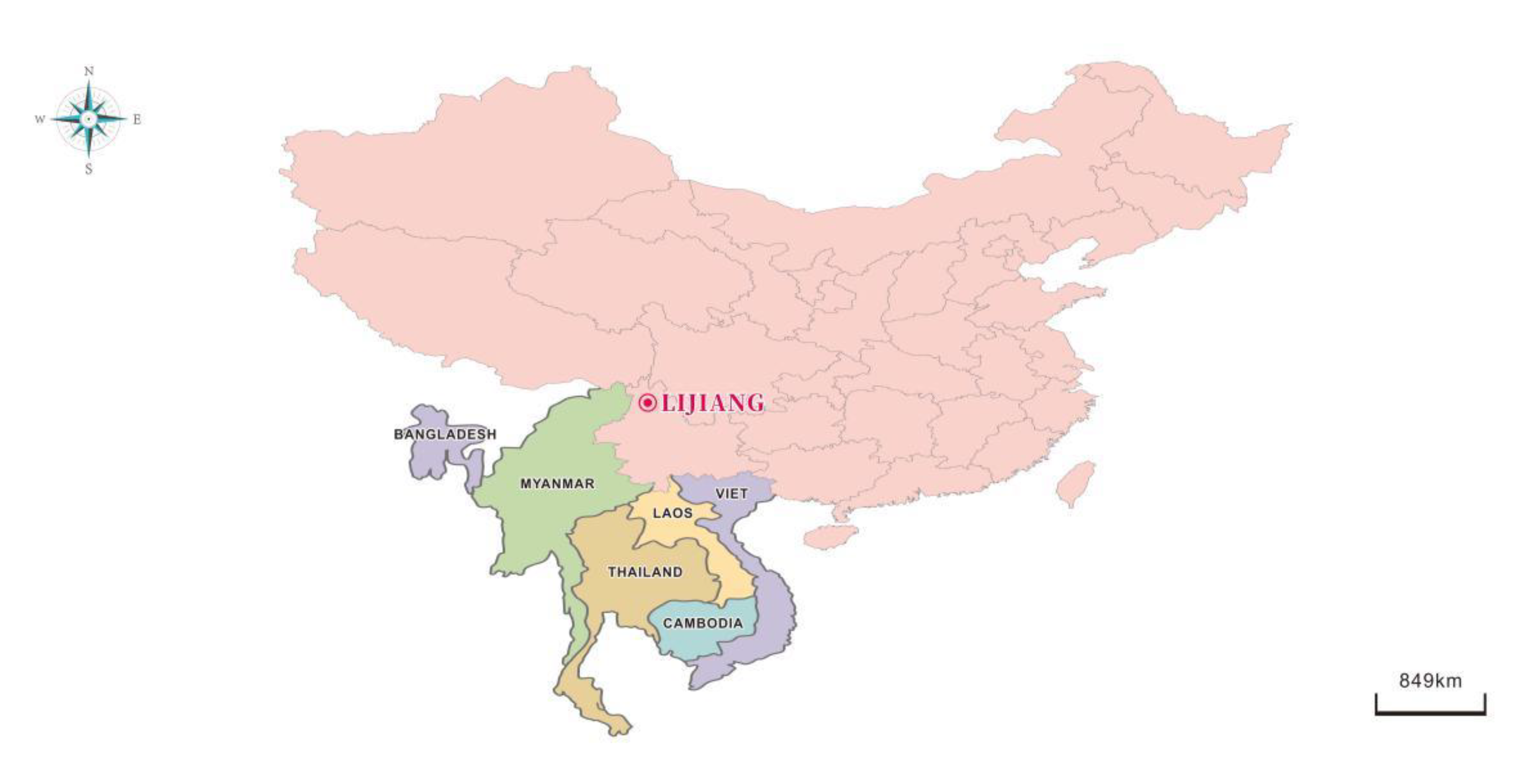
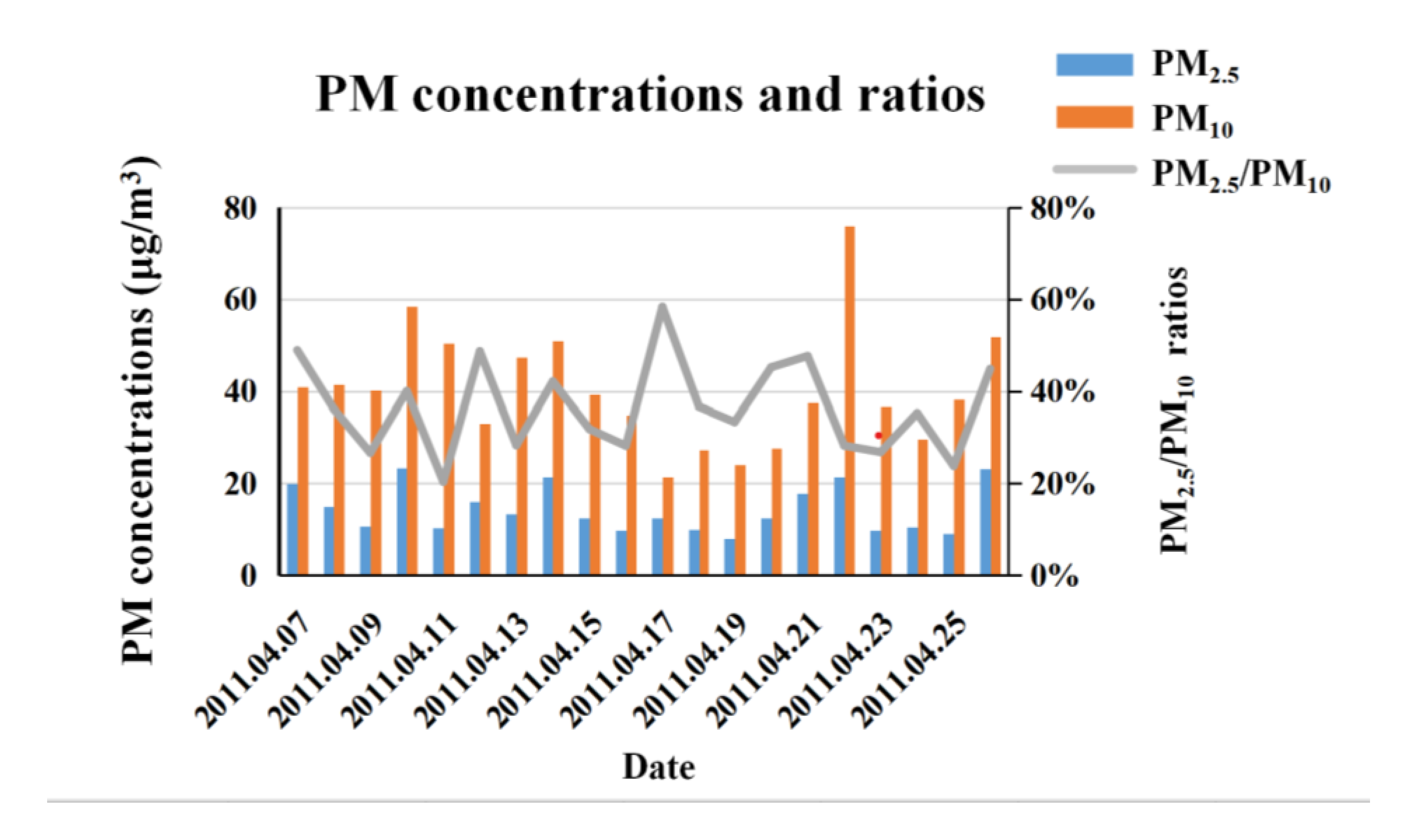
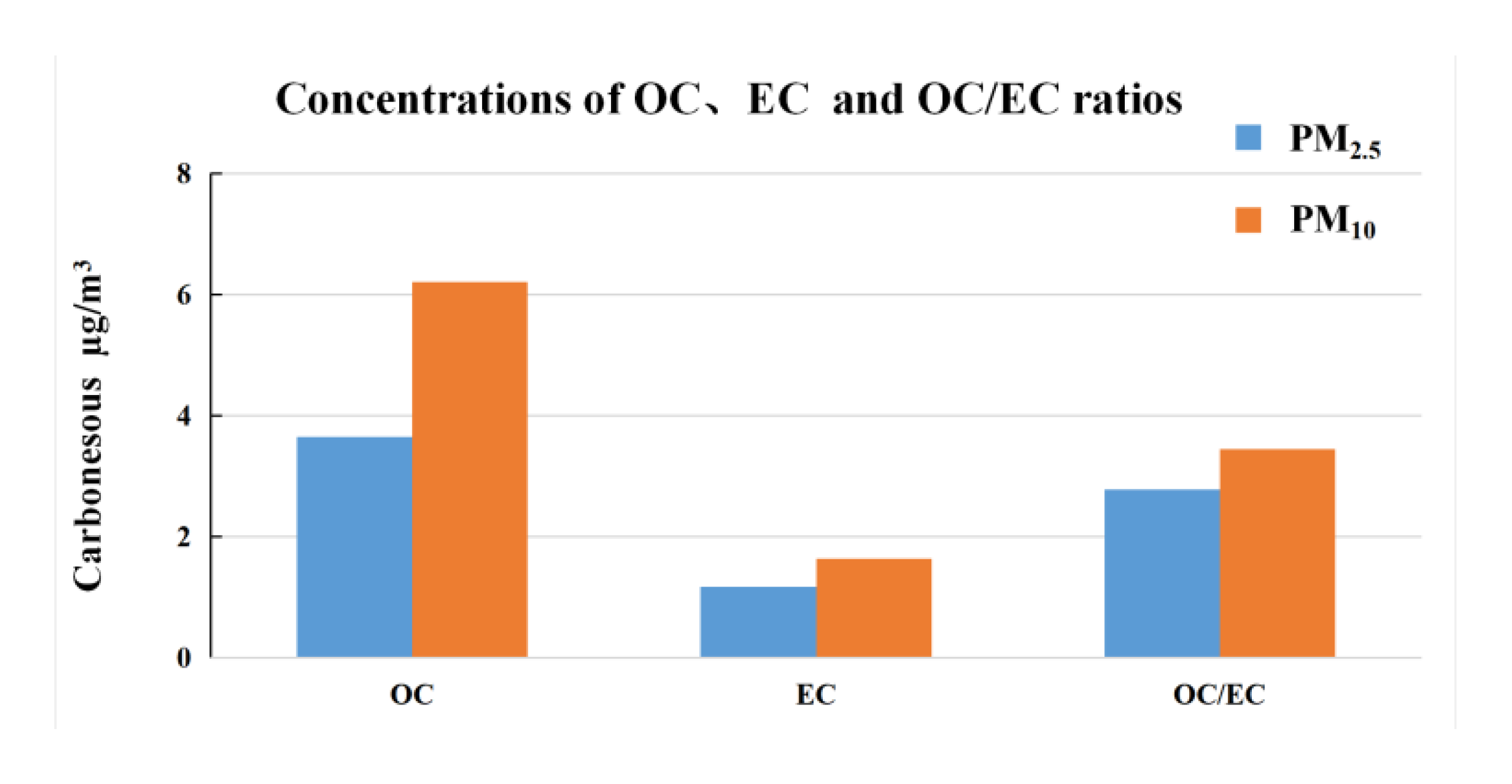
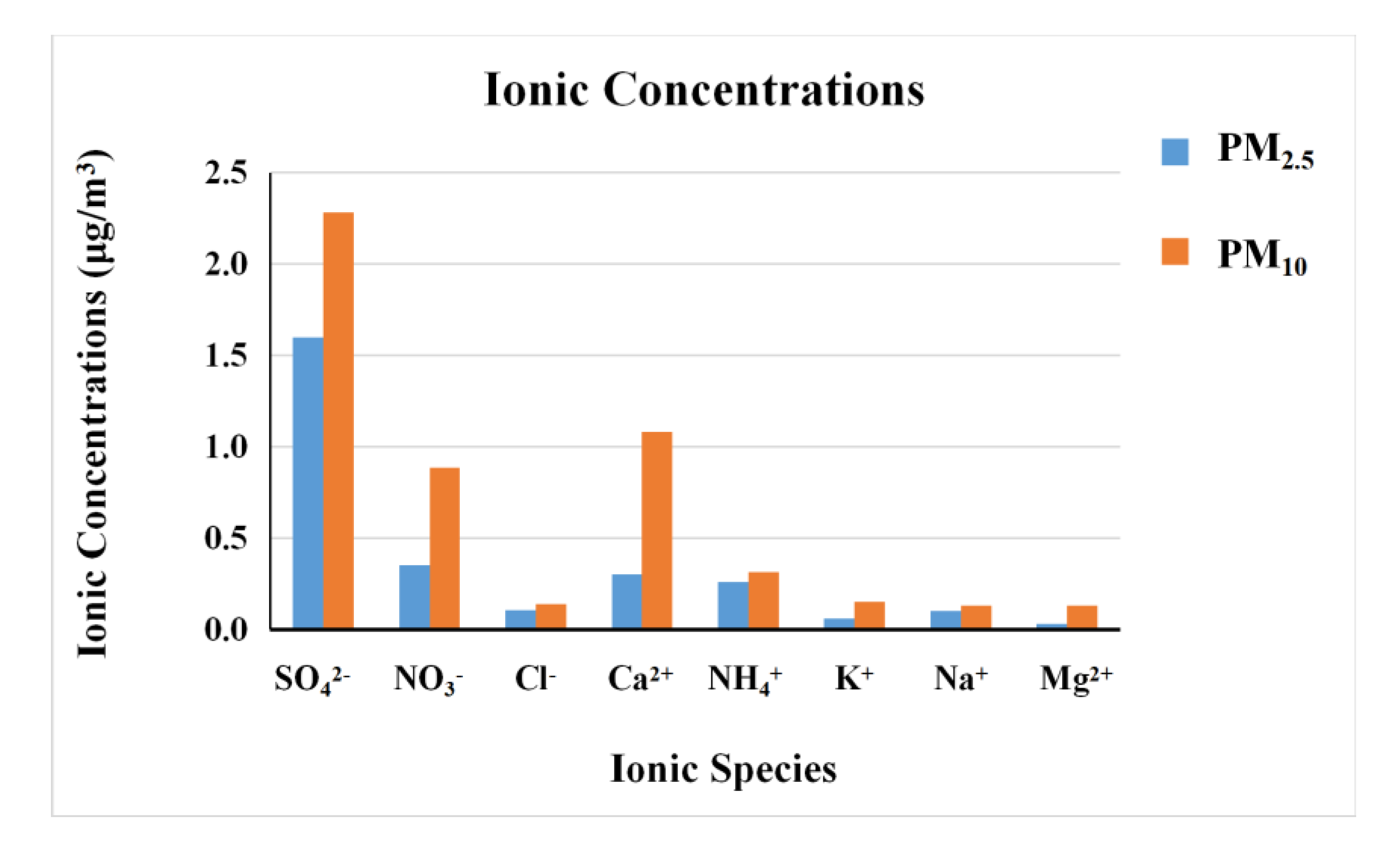
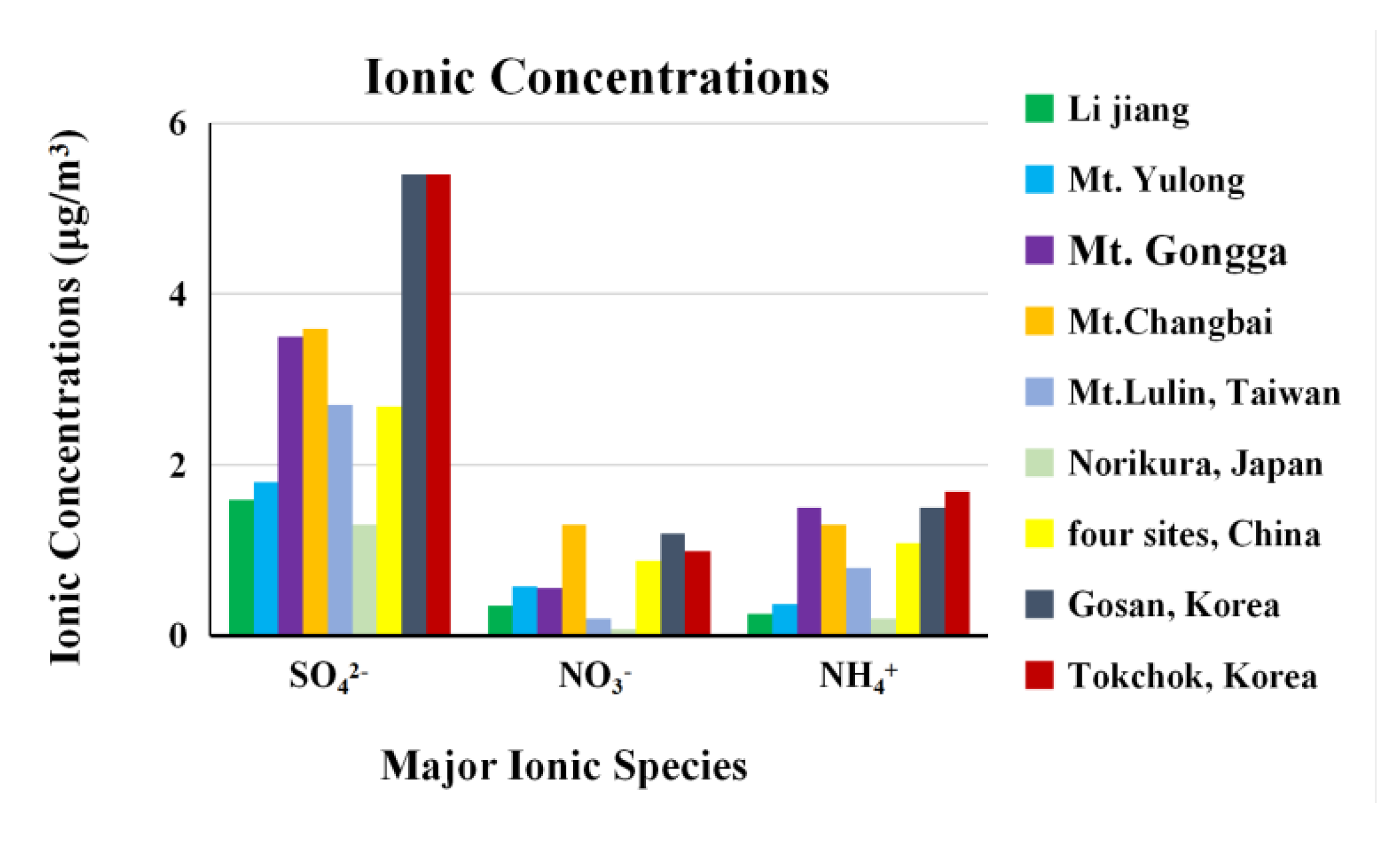
| No. | Compound | Abbreviation | Rings |
|---|---|---|---|
| 1 | Fluoranthene | Flt | 4 |
| 2 | Pyrene | Pyr | 4 |
| 3 | Benz(a)anthracene | BaA | 4 |
| 4 | Chrysene | Chr | 4 |
| 5 | Benzo(b)flfluoranthene | BbF | 5 |
| 6 | Benzo(k)flfluoranthene | BkF | 5 |
| 7 | Benzo(a)pyrene | BaP | 5 |
| 8 | Dibenz(a,h)anthracene | DBA | 5 |
| 9 | Benzo(g,h,i)perylene | BghiPe | 6 |
| 10 | Indeno(1,2,3-cd)pyrene | IDP | 6 |
| 11 | 1,6-Dinitropyrenes | 1,6-DNP | |
| 1,8-Dinitropyrenes | 1,8-DNP | ||
| 1,3-Dinitropyrenes | 1,3-DNP | ||
| 9-Nitrophenanthrene | 9-Nph | ||
| 2-Nitroanthracene | 2-NA | ||
| 9-Nitroanthracene | 9-NA | ||
| 4-Nitropyrene | 4-NP | ||
| 3-Nitrofluoranthene | 3-NFR | ||
| 1-Nitropyrene | 1-NP | ||
| 1-Nitrofluoranthene | 1-NFR | ||
| 2-Nitrotriphenylene | 2-NTP | ||
| 6-Nitrochrysene | 6-NC | ||
| 7-Nitrobenz[a]anthracene | 7-NBaA | ||
| 3-Nitroperylene | 3-Nper | ||
| 6-Nitrobenzo[a]pyrene | 6-NBaP | ||
| 1-Nitroperylene | 1-NPer | ||
| 3-Nitrobenz[a]anthracene | 3-NBA | ||
| 2-nitrofluoranthene | 2-NFr |
| Sites | Countries | Periods | PM2.5 | PM10 | PM2.5/PM10 (range) | Literature |
|---|---|---|---|---|---|---|
| Lijiang | China | 2011, Spring | 14.4 | 40.4 | 0.37(0.20–0.58) | This study |
| Changbaishan | China | 2013 | 13 | 18 | (0.55–0.84) | [24,25] |
| Pangquangou | China | 2013 | 18 | 44 | (0.17–0.74) | [24,25] |
| Shennongjia | China | 2013 | 15 | 38 | (0.24–0.75) | [24,25] |
| Nanling | China | 2013 | 21 | 30 | (0.54–0.82) | [24,25] |
| Gosan | Korea | 2007–2008 | 17.2 | 28.4 | [26] | |
| Tokchok | Korea | 1999–2000 | 18.7 | [27] | ||
| K-puszta (PM2) | Hungary | 2003, Summer | 13.6 | 24 | (0.57 ± 0.06) | [21] |
| K-puszta | Hungary | 2006, Summer | 17.4 | 25 | (0.67 ± 0.08) | [28,29] |
| Illmitz | Austria | 1998–2010 | 20 | 25 | [30] | |
| Langenbruegge | Germany | 1998–2010 | 13 | 17 | [30] | |
| Payerne | Switzerland | 1998–2010 | 17 | 20 | [30] | |
| Penausende | Spain | 1998–2010 | 8 | 12 | [30] |
| Abbreviation | 6 Apr. | 7 Apr. | 8 Apr. | 9 Apr. | 10 Apr. | 11 Apr. | 12 Apr. | 13 Apr. | Mean ± SD |
|---|---|---|---|---|---|---|---|---|---|
| Flt | 2.9 | 2.9 | 3.2 | 5.9 | 1.9 | 1.6 | 1.3 | 2.0 | 2.7 ± 1.5 |
| Pyr | 1.9 | 1.9 | 1.9 | 3.3 | 1.6 | 1.1 | 0.8 | 1.4 | 1.7 ± 0.8 |
| BaA | 1.1 | 1.0 | 1.2 | 2.3 | 0.7 | 0.5 | 0.3 | 0.6 | 1.0 ± 0.6 |
| Chr | 1.8 | 1.7 | 2.2 | 3.4 | 1.1 | 0.9 | 0.6 | 1.0 | 1.6 ± 0.9 |
| BbF | 1.4 | 1.2 | 1.6 | 2.3 | 0.9 | 0.8 | 0.6 | 1.1 | 1.2 ± 0.5 |
| BkF | 0.8 | 0.7 | 0.8 | 1.3 | 0.5 | 0.4 | 0.3 | 0.5 | 0.7 ± 0.3 |
| BaP | 1.1 | 1.1 | 1.2 | 2.0 | 0.9 | 0.7 | 0.6 | 0.9 | 1.1 ± 0.4 |
| DBA | 0.03 | 0.02 | 0.04 | 0.08 | 0.03 | 0.03 | 0.01 | 0.02 | 0.03 ± 0.02 |
| BghiPe | 1.0 | 0.8 | 1.0 | 1.4 | 0.7 | 0.7 | 0.6 | 0.9 | 0.9 ± 0.3 |
| IDP | 1.1 | 1.0 | 1.3 | 2.0 | 0.7 | 0.6 | 0.5 | 0.8 | 1.0 ± 0.5 |
| Total | 13.0 | 12.2 | 14.4 | 23.8 | 9.1 | 7.5 | 5.7 | 9.3 | 11.9 ± 5.6 |
| IDP/(BghiPe + IDP) | BaA/(Chr + BaA) | Flt/(Flt + Pyr) | |
|---|---|---|---|
| This study | 0.53 ± 0.04 | 0.45 ± 0.01 | 0.61 ± 0.03 |
| Biomass burning | 0.48–0.58 [45,46,47,48] | >0.5 [49] | 0.43–0.58 [45,46,48] |
| Coal combustion | >0.5 [47,48] | 0.2–0.5 [47,49] | >0.5 [50] |
| Diesel vehicles | 0.35–0.70 [47,48] | <0.2 [47] | 0.6–0.7 [50] |
| Gasoline vehicles | <0.2 [47] | 0.2–0.35 [49] | <0.5 [48,50] |
| Abbreviation | 6 Apr. | 7 Apr. | 8 Apr. | 9 Apr. | 10 Apr. | 11 Apr. | 12 Apr. | 13 Apr. | Mean ± SD |
|---|---|---|---|---|---|---|---|---|---|
| 1,6-DNP | 0.14 | 0.12 | 0.15 | 0.12 | 0.10 | 0.11 | 0.08 | 0.09 | 0.11 ± 0.02 |
| 1,8-DNP | 0.20 | 0.24 | 0.32 | 0.26 | 0.20 | 0.22 | 0.17 | 0.17 | 0.22 ± 0.05 |
| 1,3-DNP | 0.24 | 0.14 | 0.18 | 0.15 | 0.12 | 0.12 | 0.09 | 0.11 | 0.14 ± 0.05 |
| 9-Nph | ND | 7.37 | 8.48 | 12.28 | 4.24 | ND | ND | ND | 8.1 ± 3.3 |
| 2-NA | 0.63 | 0.69 | 0.83 | 0.92 | 0.45 | 0.42 | 0.36 | 0.47 | 0.59 ± 0.20 |
| 9-NA | 92 | 62 | 89 | 115 | 50 | 38 | 15 | 69 | 66 ± 32 |
| 4-NP | 0.54 | 0.67 | 0.77 | 0.79 | 0.47 | 0.49 | 0.52 | 0.64 | 0.61 ± 0.12 |
| 3-NFR | 0.74 | 0.87 | 1.03 | 0.76 | 0.55 | 0.57 | 0.40 | 0.49 | 0.68 ± 0.21 |
| 1-NP | 12.12 | 12.61 | 13.35 | 9.64 | 9.64 | 11.13 | 8.65 | 8.90 | 10.8 ± 1.8 |
| 1-NFR | 7.18 | 17.11 | 22.81 | 8.24 | 3.80 | 10.98 | 17.11 | 4.01 | 11.4 ± 6.9 |
| 2-NTP | 386 | 307 | 302 | 328 | 171 | 137 | 38 | 168 | 230 ± 118 |
| 6-NC | 21 | 22 | 29 | 34 | 16 | 20 | 16 | 21 | 22 ± 6.0 |
| 7-NBaA | 15.58 | 9.57 | 10.11 | 9.02 | 5.74 | 6.29 | 2.51 | 5.47 | 8.0 ± 4.0 |
| 3-Nper | 0.89 | 0.95 | 1.31 | 0.89 | 0.80 | 0.77 | 0.77 | 0.80 | 0.90 ± 0.18 |
| 6-NBaP | 3.87 | 3.57 | 4.16 | 2.82 | 2.53 | 2.68 | 2.38 | 2.35 | 3.04 ± 0.71 |
| 1-NPer | 1.78 | 1.13 | 1.19 | 1.52 | 1.22 | 0.83 | 0.80 | 1.07 | 1.19 ± 0.33 |
| 3-NBA | ND * | ND | ND | ND | ND | ND | ND | ND | |
| 2-NFr | ND * | ND | ND | ND | ND | ND | ND | ND | |
| Total | 450 | 376 | 385 | 396 | 213 | 191 | 87 | 212 | 289 ± 129 |
| Year, Location, Ref. | Ca | Mg | Fe | K | Mn | Zn | Cu | Cr | As |
|---|---|---|---|---|---|---|---|---|---|
| 2011, Lijiang, this study | 0.59 | 0.18 | 0.16 | 0.083 | 0.0031 | 0.017 | 0.0083 | 0.0080 | 0.00018 |
| 2013, 4 NAB sites [24] | 0.13 | 0.10 | 0.050 | 0.16 | 0.0080 | 0.020 | 0.0035 | 0.0020 | 0.0027 |
| 2006, Mt. Dinghu [65] | 0.83 | 0.16 | 0.57 | 1.36 | 0.033 | 0.43 | 0.060 | UD | 0.031 |
| 2008, Xinglong * [66] | 2.5 | 0.54 | 0.89 | 0.85 | 0.029 | 0.14 | 0.043 | 0.079 | 0.013 |
| 2013, Kunming [67] | ND | ND | ND | ND | 0.16 | 0.33 | 0.078 | 0.030 | 0.03 |
| 2012, Beijing [68] | ND | ND | ND | ND | 0.082 | 0.23 | 0.040 | 0.0078 | 0.012 |
Publisher’s Note: MDPI stays neutral with regard to jurisdictional claims in published maps and institutional affiliations. |
© 2020 by the authors. Licensee MDPI, Basel, Switzerland. This article is an open access article distributed under the terms and conditions of the Creative Commons Attribution (CC BY) license (http://creativecommons.org/licenses/by/4.0/).
Share and Cite
Liu, Y.; Li, X.; Wang, W.; Yin, B.; Gao, Y.; Yang, X. Chemical Characteristics of Atmospheric PM10 and PM2.5 at a Rural Site of Lijiang City, China. Int. J. Environ. Res. Public Health 2020, 17, 9553. https://doi.org/10.3390/ijerph17249553
Liu Y, Li X, Wang W, Yin B, Gao Y, Yang X. Chemical Characteristics of Atmospheric PM10 and PM2.5 at a Rural Site of Lijiang City, China. International Journal of Environmental Research and Public Health. 2020; 17(24):9553. https://doi.org/10.3390/ijerph17249553
Chicago/Turabian StyleLiu, Yu, Xurui Li, Wan Wang, Baohui Yin, Yuanguan Gao, and Xiaoyang Yang. 2020. "Chemical Characteristics of Atmospheric PM10 and PM2.5 at a Rural Site of Lijiang City, China" International Journal of Environmental Research and Public Health 17, no. 24: 9553. https://doi.org/10.3390/ijerph17249553
APA StyleLiu, Y., Li, X., Wang, W., Yin, B., Gao, Y., & Yang, X. (2020). Chemical Characteristics of Atmospheric PM10 and PM2.5 at a Rural Site of Lijiang City, China. International Journal of Environmental Research and Public Health, 17(24), 9553. https://doi.org/10.3390/ijerph17249553




